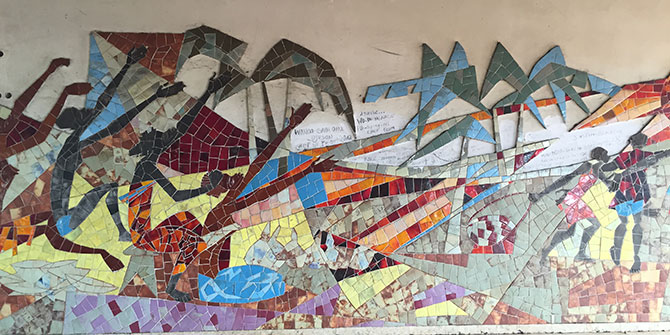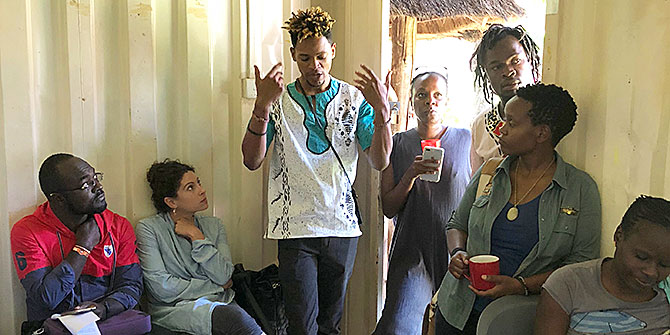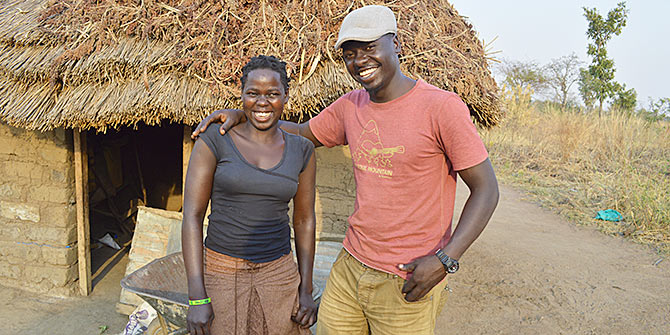By exploring the history of the TAKS Community Arts Centre in Gulu, Morris Omara and Tim Allen unveil the role of art in the healing process following the trauma of a two-decade-long civil war in northern Uganda.
This article is part of our #LSEReturn series, exploring themes around Displacement and Return.
The colonial clubhouse in Gulu, northern Uganda, still stands. Back in the last decades of the Uganda Protectorate, it was a bastion of the British establishment which administered the Acholi population of what was then Acholi District. Nearby was a carefully maintained nine-hole golf course, a swimming pool and cricket fields, which have now disappeared. The clubhouse was where the white administrators and their families relaxed. They played tennis, drank their sundowners in the bar, and rested after a trying day.
 The anthropologist, Frank Girling, visited it in 1949. In his doctoral dissertation he described ‘a centralized and all-powerful British administration under the District Commissioner’, and he describes the houses of the officials clustered around their clubhouse. Africans and Indians were barred from membership. As one member explained to him: ‘We need to have somewhere where we can get away for a time from our coloured brothers.’ Girling observed that: ‘All the Europeans are subject to a greater or less degree to the current myths about the Acholi, which serve to maintain the unity and cohesiveness of the European group.’ One particularly absurd notion he highlights was that the minds of Nilotes (a term for the Acholi and other Africans speaking Nilotic languages) could be contrasted with the Bantu mind (i.e. the mind of Bantu-speaking Africans, such as those living in Kampala and southern Uganda). It was suggested that the former work in the same way as Europeans, while the latter ‘twists and turns in to all sorts of queer channels.’ Girling suggests, this view may have been linked to ‘a strongly expressed affection for the illiterate pagan Acholi’, and openly-stated antipathy towards the ‘half-educated native’. Some Europeans, he also tells us were ‘indifferent to the condition of the people’, while others regarded themselves as ‘the bearers of a civilising mission’.
The anthropologist, Frank Girling, visited it in 1949. In his doctoral dissertation he described ‘a centralized and all-powerful British administration under the District Commissioner’, and he describes the houses of the officials clustered around their clubhouse. Africans and Indians were barred from membership. As one member explained to him: ‘We need to have somewhere where we can get away for a time from our coloured brothers.’ Girling observed that: ‘All the Europeans are subject to a greater or less degree to the current myths about the Acholi, which serve to maintain the unity and cohesiveness of the European group.’ One particularly absurd notion he highlights was that the minds of Nilotes (a term for the Acholi and other Africans speaking Nilotic languages) could be contrasted with the Bantu mind (i.e. the mind of Bantu-speaking Africans, such as those living in Kampala and southern Uganda). It was suggested that the former work in the same way as Europeans, while the latter ‘twists and turns in to all sorts of queer channels.’ Girling suggests, this view may have been linked to ‘a strongly expressed affection for the illiterate pagan Acholi’, and openly-stated antipathy towards the ‘half-educated native’. Some Europeans, he also tells us were ‘indifferent to the condition of the people’, while others regarded themselves as ‘the bearers of a civilising mission’.
Girling was visited in Gulu by a friend who he had met at Cambridge University. That was Ramkrishna Mukherjee, who was to go on to have a distinguished academic career. However, British officials had a different attitude to him as an Indian in Uganda than his teachers in England. Visits to the clubhouse in Gulu required a special invitation from a member. Indians, like Africans, were occasionally welcomed as exceptions. Moreover, both Ramkrishna and Girling were highly critical of colonial rule, and had communist sympathies. Girling was a veteran of the Spanish Civil War and of the Indian Army during the Second World War, and had little time for the patronising racism he encountered in the Ugandan Protectorate. Perhaps unsurprisingly, Girling was barred from Uganda in 1950, and returned to England. His doctoral thesis was eventually published, but with the passages about the clubhouse and other critical passages censored by the British Colonial Office.

Archive Image provided by Morris Omara
After its heyday in the Protectorate era, the clubhouse fell into decay. In the 1960s, it was close to the Presidential State Lodge, which Milton Obote, then Uganda’s leader, occasionally visited. Meanwhile, Obote’s friend and sparring partner, the great Acholi poet and cultural icon, Okot p’Bitek established the Gulu Festival and the famous dance group, Heartbeat Africa. Then after the overthrow of Obote by Idi Amin in 1971, life in Gulu as a whole became very difficult (Amin’s regime oppressed various groups in Uganda, including the Acholi people). By the 1980s, after the Tanzanian invasion – which overthrew Amin, the buildings were crumbling into ruins, and the old sports facilities – had disappeared under vegetation and urban rubbish.

However, this did not hinder the people of Gulu from trying to make the best out of it. Through the political upheavals and armed conflicts which affected the region in the late 1980s and mid-90s, the clubhouse was used as a martial arts training centre (with a particular focus on taekwondo). Many of the exceptional taekwondo athletes in the sub-region recall how they trained at the former clubhouse grounds. Then, the latter part of the 90s witnessed the transformation of the site into an education centre in the name of Universal Standard College. This, however, only lasted for slightly over half a decade. At that point, the site was eventually bought by ceramic artist, David Lukani Odwar, and transformed into an art and cultural centre for the people of Acholi sub-region.

Image Credit: Tim Allen
Mr Odwar stressed that since the region has been through a very long, dreadful and bloody civil war stretching over two decades, the Acholi people needed a therapeutic art centre where they can heal from all the trauma and start rebuilding their lives. To this effect, he called it the TAKS Community Art Centre. TAKS is an abbreviation standing for “Through Art Keep Smiling”. Indeed, the artistic and therapeutic centre has kept the local people smiling, as thus states the mission statement: “To engage the people of Northern Uganda in the creative Arts so that they can reaffirm the richness of their culture, reassert their humanity, re-establish the value of their education, take pride in themselves and develop the skills which will help them find new options for their lives and eventually employment”.

Image Credit: Morris Omara
Today, TAKS Community Art Centre retains only faint reminders of the former colonial clubhouse which was a symbol of white supremacy in the period preceding Uganda’s independence. The grass around the remains of the tennis court is trimmed, and one of the net posts remains. The bar is structurally more or less as it was – but with very different decorations. On the wall outside are paintings by Ivan Okot depicting Acholi dancing and Acholi cooking, and there are the portraits of two Acholi heroes: Okot p’Bitek and Matthew Lukwiya. The work of the former was celebrated in an event held last year, attended by many who knew him. The latter is revered by the Acholi people for his long commitment to his people as a medical doctor, and the selfless care he provided for those infected with Ebola during the Gulu outbreak of 2000. He saved so many lives, but tragically died of the disease himself.

Matthew Lukwiya’s portrait is on the TAKS Centre wall in the background.
Image Credit Tim Allen
Nowadays TAKS is a symbol of revival, recovery, talent development, creativity and an engagement hub for the local people, operating purely on the principles of a community-based organisation. Unlike the clubhouse of the past, there is no exclusion of any groups, and white visitors mingle with Africans, taking advantage of the TAKS’ facilities, including internet services and computers. There is an annual film festival which attracts large audiences, and many workshops and cultural events. For several years the Bayimba foundation also held an annual festival of arts and culture at TAKS where, following the legacy of P’Bitek, poets, visual artists and musical icons such as Bobi Wine have performed and showcased their talents. The centre has nurtured many young talents into productive and empowered people, training and equipping the youth with various skills in the various small income generating activities. What was once a place of colonial domination has become a place of empowerment for everyone.

Postcript: A book, presenting the ethnographic work of Frank Girling and Okot p’Bitek on the Acholi of Uganda is currently in press (Lawino’s People: The Acholi of Uganda by Okot p’Bitek and Frank Girling, Introduced and edited by Tim Allen). Bobi Wine, the popular musician mentioned in the blog who performed at the TAKS Centre, later became a Ugandan Member of Parliament, and at the time of writing had narrowly escaped an assassination attempt.
Find out more about the Politics of Return and our Trajectories of Displacement research projects, which are based at the Firoz Lalji Centre for Africa and funded by ESRC/AHRC.
Morris Omara is a freelance writer, radio presenter and volunteer Public Relations and Communication Officer of TAKS Community Art Centre, Gulu.
Tim Allen is Professor of Development Anthropology at LSE and Director of the Firoz Lalji Centre for Africa.
The views expressed in this post are those of the author and in no way reflect those of the Africa at LSE blog, the Firoz Lalji Centre for Africa or the London School of Economics and Political Science.





